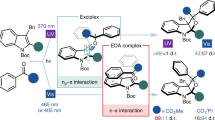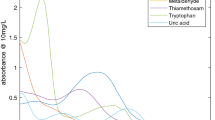Abstract
IN recent publications1, it has been shown that the absorption of light by a mixture of two reacting substances is greater than the absorptions of the reacting substances considered separately. Thus the absorption in the visible and ultra-violet regions by a mixture of N/400 aqueous iodine and 2N potassium oxalate is much greater than the light absorption by N/800 aqueous iodine and N potassium oxalate taken separately. This relation has been observed with numerous chemical reactions taking place in aqueous solutions.
This is a preview of subscription content, access via your institution
Access options
Subscribe to this journal
Receive 51 print issues and online access
$199.00 per year
only $3.90 per issue
Buy this article
- Purchase on Springer Link
- Instant access to full article PDF
Prices may be subject to local taxes which are calculated during checkout
Similar content being viewed by others
References
Dhar and Bhattacharya, J. Indian Chem. Soc., 11, 33, 311 ; 1934. Dhar and Kar, ibid., 11, 629 ; 1934.
H. B. Baker, J. Chem. Soc., 65, 611 ; 1894: 81, 400 ; 1902.
Weigert and Kellermann, Z. phys. Chem., 107, 1 ; 1923.
Henri and Landau, C. R., 158, 181 ; 1913.
J. C. Ghosh and collaborators, J. Indian Chem. Soc., 4, 353 ; 1927: 5, 191, 569 ; 1928.
Fajans and Karagunis, Z. phys. Chem., (B), 5, 385 ; 1929.
Author information
Authors and Affiliations
Rights and permissions
About this article
Cite this article
DHAR, N., BHARGAVA, P. Chemical Reactivity and Absorption of Light. Nature 134, 848–849 (1934). https://doi.org/10.1038/134848c0
Issue Date:
DOI: https://doi.org/10.1038/134848c0
This article is cited by
-
Absorption of Light in Gases
Nature (1934)
Comments
By submitting a comment you agree to abide by our Terms and Community Guidelines. If you find something abusive or that does not comply with our terms or guidelines please flag it as inappropriate.



